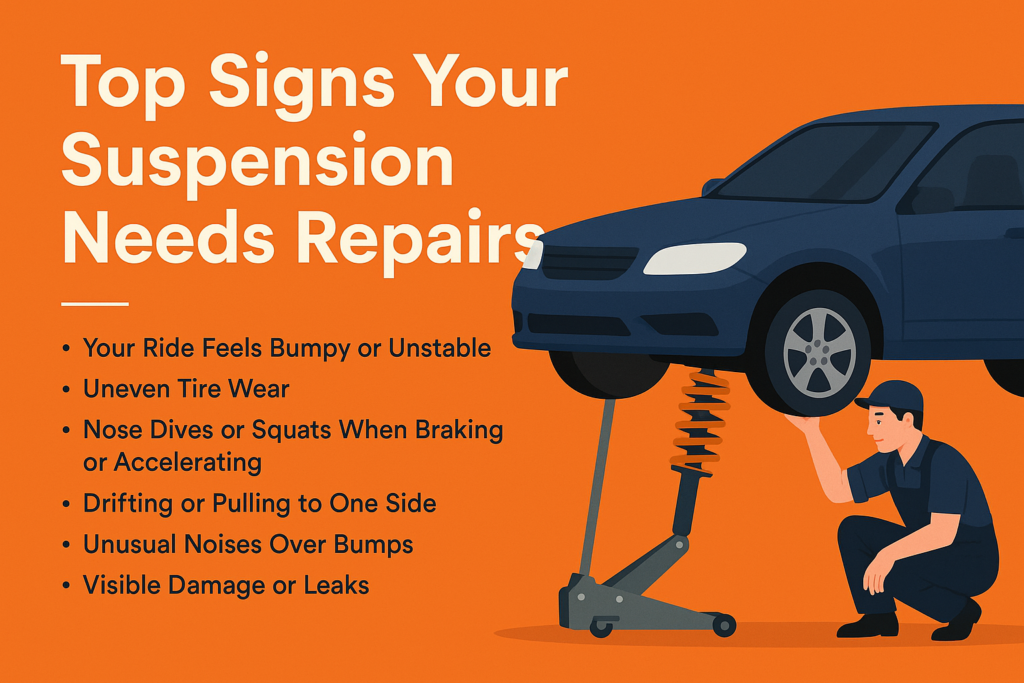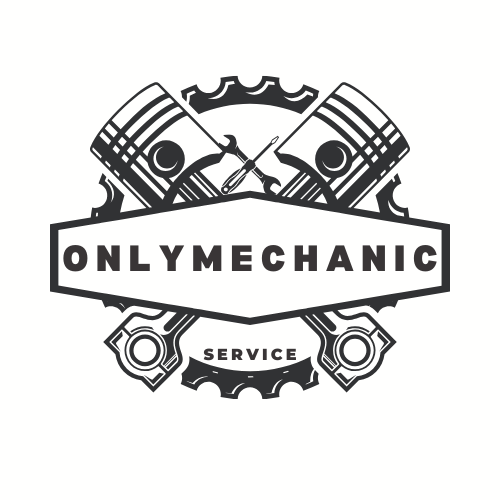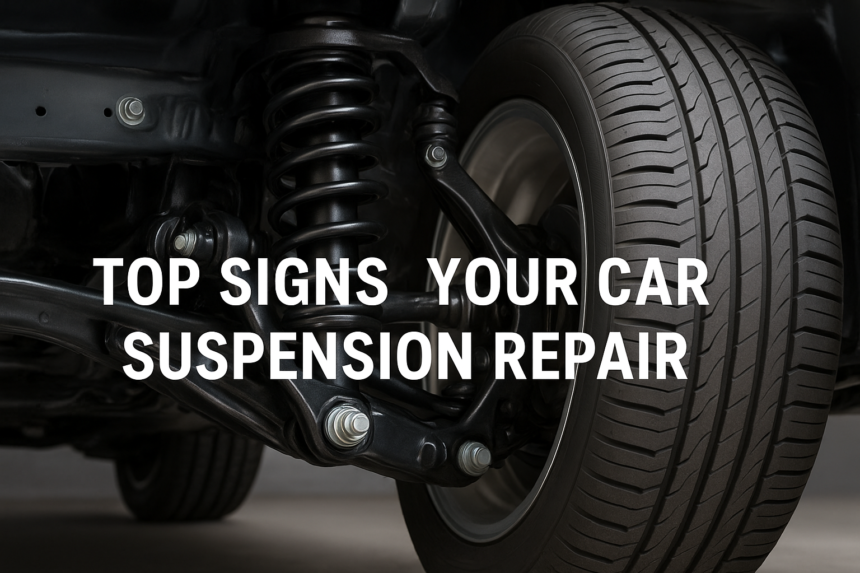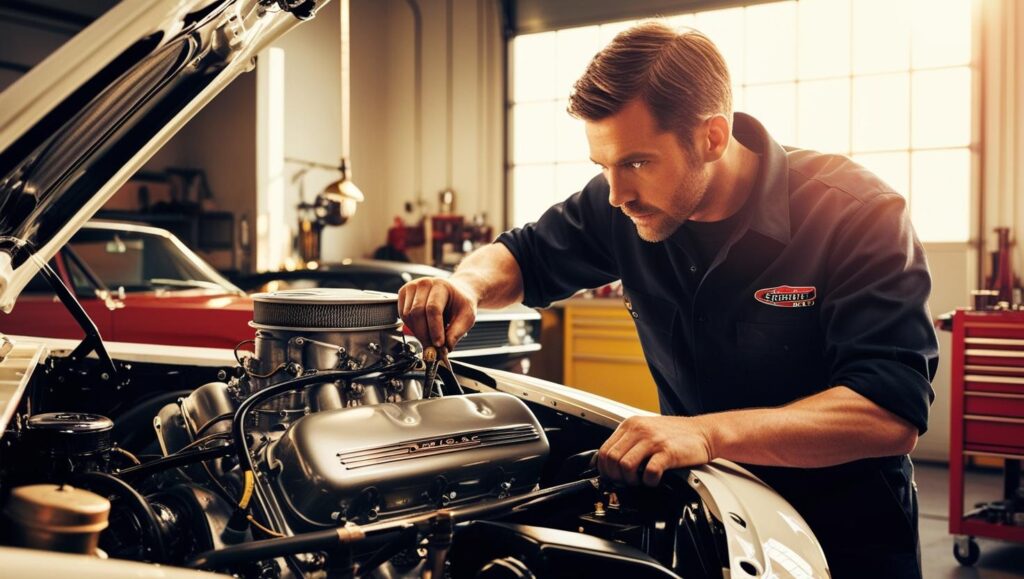Your vehicle’s suspension system is more than just springs and shocks—it’s the backbone of a smooth, safe, and controlled driving experience. Whether you drive a compact city car, a rugged SUV, or a heavy-duty truck, your suspension absorbs road impacts, keeps your tires in contact with the road, and ensures stable handling.
But like any component, it wears out over time. Ignoring the signs of suspension problems can lead to dangerous driving conditions, costly repairs, and even damage to other parts of your vehicle.
In this guide, we’ll cover the top signs your car suspension repair—and why acting early can save you time, money, and headaches.
1. Your Ride Feels Bumpy or Unstable
A comfortable ride is one of the most obvious benefits of a healthy suspension. If you suddenly notice your car feels rough, bouncy, or unstable—especially on roads you drive daily—it could indicate worn-out shocks or struts.
- What to look for:
- Excessive bouncing after hitting a bump
- Swaying during turns
- Feeling like the vehicle “floats” instead of hugging the road
💡 Pro tip: Try the “bounce test”—push down firmly on the hood or trunk. If your car bounces more than two to three times before settling, your suspension likely needs attention.
2. Uneven Tire Wear
Your suspension plays a key role in maintaining proper wheel alignment. When it’s compromised, your tires won’t make even contact with the road, causing irregular or uneven tire wear.
- Possible causes:
- Misaligned suspension
- Damaged control arms or bushings
- Weak shocks causing tire “cupping”
🔧 Fixing suspension problems early can extend tire life and prevent premature replacements.
3. Nose Dives or Squats When Braking or Accelerating
If your vehicle nose-dives when braking or squats when accelerating, it’s a strong indicator that your shocks or struts are worn. This not only affects comfort but also reduces braking efficiency, increasing stopping distance—a serious safety risk.
4. Drifting or Pulling to One Side
A well-functioning suspension keeps your vehicle driving straight. If your car drifts or pulls to one side, even on a straight road, it might signal:
- Damaged suspension components
- Misaligned wheels
- Uneven tire pressure (though simpler to fix, it’s worth checking first)
🚨 Safety warning: Drifting can reduce vehicle control, especially during emergency maneuvers.
5. Unusual Noises Over Bumps
A healthy suspension system should operate quietly. Clunking, knocking, or squeaking sounds when going over bumps can point to:
- Worn ball joints
- Loose bushings
- Damaged control arms or stabilizer links
Ignoring these noises can result in parts breaking completely, leading to sudden loss of steering stability.
6. Visible Damage or Leaks
Sometimes the signs are obvious. If you spot oil or fluid leaks near your wheels, your shocks or struts might be leaking hydraulic fluid, rendering them ineffective. Also check for:
- Broken springs
- Bent control arms
- Corroded mounting points
A quick visual inspection can help you catch these issues before they escalate.
Why You Shouldn’t Delay Suspension Repairs
Driving with a faulty suspension isn’t just uncomfortable—it’s unsafe. A worn-out suspension:
- Increases stopping distance
- Reduces steering precision
- Causes faster tire wear
- Puts stress on other components like the steering rack and chassis
In short: Fixing small suspension issues early prevents bigger, more expensive problems down the road.
When to See a Mechanic
If you notice one or more of these signs, have your suspension inspected by a qualified mechanic immediately. They can pinpoint the exact cause, recommend repairs, and restore your vehicle’s safety and performance.
Final Thoughts
Your car’s suspension system works silently in the background—until it doesn’t. By staying alert to the warning signs, you can keep your ride smooth, safe, and efficient.
Remember: A well-maintained suspension isn’t just about comfort—it’s about control, safety, and peace of mind.




Great value cleaning service, budget-conscious choice that works. Affordable excellence discovered. Smart choice made.
We are looking for partnerships with other businesses for mutual promotion. Please contact us for more information!
Business Name: Sparkly Maid NYC Cleaning Services
Address: 447 Broadway 2nd floor #523, New York, NY 10013, United States
Phone Number: +1 646-585-3515
Website: https://sparklymaidnyc.com
We pay $10 for a google review and We are looking for partnerships with other businesses for Google Review Exchange. Please contact us for more information!
Business Name: Sparkly Maid NYC Cleaning Services
Address: 447 Broadway 2nd floor #523, New York, NY 10013, United States
Phone Number: +1 646-585-3515
Website: https://sparklymaidnyc.com
We pay $10 for a google review and We are looking for partnerships with other businesses for Google Review Exchange. Please contact us for more information!
Business Name: Sparkly Maid NYC Cleaning Services
Address: 447 Broadway 2nd floor #523, New York, NY 10013, United States
Phone Number: +1 646-585-3515
Website: https://sparklymaidnyc.com
We pay $10 for a google review and We are looking for partnerships with other businesses for Google Review Exchange. Please contact us for more information!
Business Name: Sparkly Maid NYC Cleaning Services
Address: 447 Broadway 2nd floor #523, New York, NY 10013, United States
Phone Number: +1 646-585-3515
Website: https://sparklymaidnyc.com
Sweet internet site, super design, really clean and utilise pleasant.
We pay $10 for a google review and We are looking for partnerships with other businesses for Google Review Exchange. Please contact us for more information!
Business Name: Sparkly Maid NYC Cleaning Services
Address: 447 Broadway 2nd floor #523, New York, NY 10013, United States
Phone Number: +1 646-585-3515
Website: https://maps.app.goo.gl/u9iJ9RnactaMEEie8
It?¦s truly a great and useful piece of information. I am happy that you shared this helpful information with us. Please keep us informed like this. Thanks for sharing.
We pay $10 for a google review and We are looking for partnerships with other businesses for Google Review Exchange. Please contact us for more information!
Business Name: Sparkly Maid NYC Cleaning Services
Address: 447 Broadway 2nd floor #523, New York, NY 10013, United States
Phone Number: +1 646-585-3515
Website: https://maps.app.goo.gl/u9iJ9RnactaMEEie8
I think this is among the most vital information for me. And i am glad reading your article. But should remark on few general things, The web site style is perfect, the articles is really excellent : D. Good job, cheers
We pay $10 for a google review and We are looking for partnerships with other businesses for Google Review Exchange. Please contact us for more information!
Business Name: Sparkly Maid NYC Cleaning Services
Address: 447 Broadway 2nd floor #523, New York, NY 10013, United States
Phone Number: +1 646-585-3515
Website: https://maps.app.goo.gl/u9iJ9RnactaMEEie8
We pay $10 for a google review and We are looking for partnerships with other businesses for Google Review Exchange. Please contact us for more information!
Business Name: Sparkly Maid NYC Cleaning Services
Address: 47 Broadway 2nd floor #523, New York, NY 10013, United States
Phone Number: +1 646-585-3515
Website: https://maps.app.goo.gl/u9iJ9RnactaMEEie8
I?¦ve been exploring for a little for any high-quality articles or weblog posts on this sort of area . Exploring in Yahoo I finally stumbled upon this site. Studying this info So i?¦m glad to convey that I have an incredibly good uncanny feeling I discovered exactly what I needed. I such a lot unquestionably will make certain to do not fail to remember this web site and give it a look regularly.
Its excellent as your other posts : D, thankyou for posting.
I have recently started a website, the info you offer on this site has helped me tremendously. Thanks for all of your time & work.
I very lucky to find this web site on bing, just what I was looking for : D likewise saved to fav.
Throughout this grand design of things you’ll secure an A+ for hard work. Where exactly you actually lost everybody ended up being on the details. As it is said, the devil is in the details… And it couldn’t be much more correct here. Having said that, permit me tell you exactly what did give good results. Your article (parts of it) is definitely pretty convincing and that is most likely the reason why I am taking the effort to comment. I do not make it a regular habit of doing that. 2nd, whilst I can certainly notice the jumps in logic you make, I am not necessarily certain of exactly how you seem to connect the ideas that make the actual conclusion. For now I will, no doubt subscribe to your issue however wish in the near future you connect the dots better.
Hmm it seems like your website ate my first comment (it was super long) so I guess I’ll just sum it up what I had written and say, I’m thoroughly enjoying your blog. I too am an aspiring blog writer but I’m still new to everything. Do you have any helpful hints for beginner blog writers? I’d genuinely appreciate it.
Hi! This is my first comment here so I just wanted to give a quick shout out and say I really enjoy reading through your posts. Can you suggest any other blogs/websites/forums that deal with the same topics? Thank you so much!
I have been absent for a while, but now I remember why I used to love this site. Thank you, I will try and check back more often. How frequently you update your website?
I’ve been absent for a while, but now I remember why I used to love this web site. Thanks, I will try and check back more often. How frequently you update your website?
Hello, you used to write magnificent, but the last few posts have been kinda boring?K I miss your tremendous writings. Past few posts are just a bit out of track! come on!
I’m not sure exactly why but this web site is loading extremely slow for me. Is anyone else having this problem or is it a issue on my end? I’ll check back later and see if the problem still exists.
Thank you for sharing excellent informations. Your web-site is very cool. I’m impressed by the details that you have on this site. It reveals how nicely you perceive this subject. Bookmarked this web page, will come back for extra articles. You, my pal, ROCK! I found simply the info I already searched all over the place and simply could not come across. What a perfect web-site.
Lovely just what I was searching for.Thanks to the author for taking his clock time on this one.
Nice post. I learn something more challenging on different blogs everyday. It will always be stimulating to read content from other writers and practice a little something from their store. I’d prefer to use some with the content on my blog whether you don’t mind. Natually I’ll give you a link on your web blog. Thanks for sharing.
Thank you for the sensible critique. Me & my neighbor were just preparing to do some research on this. We got a grab a book from our area library but I think I learned more from this post. I am very glad to see such excellent info being shared freely out there.
I like this web blog so much, saved to favorites. « I don’t care what is written about me so long as it isn’t true. » by Dorothy Parker.
My wife and i felt so peaceful when Raymond managed to round up his inquiry via the precious recommendations he gained through the site. It is now and again perplexing to simply continually be releasing tips that many people could have been selling. And now we see we have got the writer to appreciate for this. The main illustrations you have made, the straightforward website menu, the friendships you will make it easier to foster – it’s all amazing, and it’s facilitating our son in addition to us imagine that the theme is enjoyable, and that’s quite pressing. Thanks for all!
Howdy would you mind letting me know which hosting company you’re working with? I’ve loaded your blog in 3 completely different browsers and I must say this blog loads a lot quicker then most. Can you recommend a good hosting provider at a fair price? Thanks a lot, I appreciate it!
Thanks for ones marvelous posting! I certainly enjoyed reading it, you are a great author.I will make certain to bookmark your blog and may come back later in life. I want to encourage one to continue your great job, have a nice morning!
You made some first rate points there. I seemed on the internet for the difficulty and found most people will go along with with your website.
What i don’t understood is if truth be told how you’re no longer really a lot more neatly-appreciated than you might be now. You’re so intelligent. You realize therefore significantly on the subject of this matter, produced me individually imagine it from numerous various angles. Its like men and women aren’t interested unless it’s one thing to accomplish with Girl gaga! Your own stuffs excellent. All the time take care of it up!
I loved as much as you’ll receive carried out right here. The sketch is tasteful, your authored material stylish. nonetheless, you command get bought an nervousness over that you wish be delivering the following. unwell unquestionably come further formerly again since exactly the same nearly very often inside case you shield this hike.
Thanx for the effort, keep up the good work Great work, I am going to start a small Blog Engine course work using your site I hope you enjoy blogging with the popular BlogEngine.net.Thethoughts you express are really awesome. Hope you will right some more posts.
You actually make it appear so easy together with your presentation but I in finding this topic to be actually something which I think I would never understand. It kind of feels too complicated and extremely huge for me. I’m having a look forward on your subsequent submit, I¦ll attempt to get the hold of it!
I’m really enjoying the theme/design of your blog. Do you ever run into any browser compatibility problems? A couple of my blog visitors have complained about my website not working correctly in Explorer but looks great in Firefox. Do you have any ideas to help fix this problem?
Really superb information can be found on site. « Every obstacle yields to stern resolve. » by Leonardo DaVinci.
I’ve learn a few just right stuff here. Definitely worth bookmarking for revisiting. I wonder how a lot effort you put to make any such great informative web site.
I like this site very much, Its a really nice position to read and incur info .
You should take part in a contest for one of the best blogs on the web. I will recommend this site!
We stumbled over here coming from a different web address and thought I should check things out. I like what I see so i am just following you. Look forward to looking into your web page yet again.
I really like your writing style, superb information, regards for posting : D.
It’s a pity you don’t have a donate button! I’d definitely donate to this brilliant blog! I suppose for now i’ll settle for bookmarking and adding your RSS feed to my Google account. I look forward to brand new updates and will talk about this blog with my Facebook group. Chat soon!
Pretty section of content. I just stumbled upon your blog and in accession capital to say that I acquire in fact loved account your blog posts. Anyway I’ll be subscribing on your augment or even I fulfillment you get admission to consistently rapidly.
Amazing! This blog looks just like my old one! It’s on a entirely different subject but it has pretty much the same page layout and design. Great choice of colors!
Thanks for sharing superb informations. Your website is so cool. I’m impressed by the details that you have on this web site. It reveals how nicely you perceive this subject. Bookmarked this website page, will come back for extra articles. You, my pal, ROCK! I found simply the info I already searched all over the place and simply could not come across. What a great site.
Excellent site. A lot of helpful information here. I am sending it to several buddies ans additionally sharing in delicious. And naturally, thank you to your effort!
Hey There. I found your blog using msn. This is a really well written article. I’ll be sure to bookmark it and return to read more of your useful info. Thanks for the post. I’ll certainly return.
It is best to take part in a contest for one of the best blogs on the web. I’ll advocate this web site!
Of course, what a magnificent website and illuminating posts, I surely will bookmark your site.Best Regards!
I really appreciate this post. I?¦ve been looking all over for this! Thank goodness I found it on Bing. You’ve made my day! Thanks again
My spouse and i were absolutely satisfied when Raymond managed to carry out his homework with the ideas he got from your very own weblog. It is now and again perplexing just to continually be releasing concepts which often the others could have been selling. And we know we have got the website owner to thank because of that. All the illustrations you made, the straightforward site menu, the friendships your site help promote – it’s got all powerful, and it’s really facilitating our son in addition to our family feel that the theme is awesome, and that’s truly indispensable. Many thanks for the whole thing!
Hi there! Do you use Twitter? I’d like to follow you if that would be okay. I’m undoubtedly enjoying your blog and look forward to new updates.
Enjoyed reading this, very good stuff, appreciate it. « Love begets love, love knows no rules, this is the same for all. » by Virgil.
I like the helpful information you provide in your articles. I will bookmark your weblog and check again here regularly. I’m quite sure I’ll learn plenty of new stuff right here! Good luck for the next!
Some times its a pain in the ass to read what blog owners wrote but this website is real user pleasant! .
I have to express appreciation to this writer for rescuing me from such a problem. Because of scouting throughout the search engines and seeing notions which are not pleasant, I believed my life was over. Living minus the solutions to the issues you’ve fixed by means of the website is a serious case, and ones which might have in a wrong way affected my career if I had not noticed the blog. Your actual natural talent and kindness in touching every aspect was very useful. I don’t know what I would’ve done if I hadn’t discovered such a subject like this. I can also now relish my future. Thanks for your time very much for the expert and effective help. I will not hesitate to endorse your blog to anyone who ought to have guidance on this subject.
At this time it sounds like BlogEngine is the top blogging platform available right now. (from what I’ve read) Is that what you’re using on your blog?
Very efficiently written post. It will be beneficial to anybody who utilizes it, as well as me. Keep up the good work – i will definitely read more posts.
I went over this website and I conceive you have a lot of wonderful information, bookmarked (:.
Keep working ,impressive job!
Does your blog have a contact page? I’m having problems locating it but, I’d like to send you an e-mail. I’ve got some recommendations for your blog you might be interested in hearing. Either way, great blog and I look forward to seeing it expand over time.
I was reading some of your blog posts on this website and I conceive this web site is rattling informative ! Keep on posting.
The Pink Salt Trick is a minimalist but effective morning routine: Just drink a glass of lukewarm water mixed with a pinch of Himalayan pink salt as soon as you wake up.
The Pink Salt Trick is a minimalist but effective morning routine: Just drink a glass of lukewarm water mixed with a pinch of Himalayan pink salt as soon as you wake up.
The Pink Salt Trick is a minimalist but effective morning routine: Just drink a glass of lukewarm water mixed with a pinch of Himalayan pink salt as soon as you wake up.
A person essentially help to make significantly articles I might state. That is the very first time I frequented your web page and up to now? I amazed with the analysis you made to make this actual put up incredible. Excellent job!
The Pink Salt Trick is a minimalist but effective morning routine: Just drink a glass of lukewarm water mixed with a pinch of Himalayan pink salt as soon as you wake up.
Hey There. I discovered your blog the usage of msn. This is an extremely neatly written article. I’ll make sure to bookmark it and return to read extra of your helpful info. Thank you for the post. I’ll certainly comeback.
What’s Happening i’m new to this, I stumbled upon this I’ve found It absolutely useful and it has aided me out loads. I’m hoping to give a contribution & assist different users like its helped me. Great job.
Thank you for the good writeup. It in truth used to be a entertainment account it. Glance complex to more brought agreeable from you! By the way, how can we be in contact?
I was examining some of your blog posts on this website and I believe this website is real informative! Keep on putting up.
The Pink Salt Trick is a minimalist but effective morning routine: Just drink a glass of lukewarm water mixed with a pinch of Himalayan pink salt as soon as you wake up.
Write more, thats all I have to say. Literally, it seems as though you relied on the video to make your point. You obviously know what youre talking about, why throw away your intelligence on just posting videos to your site when you could be giving us something informative to read?
I’ve been absent for some time, but now I remember why I used to love this web site. Thanks, I will try and check back more frequently. How frequently you update your website?
It’s arduous to search out knowledgeable people on this matter, however you sound like you recognize what you’re speaking about! Thanks
Exactly what I was searching for, regards for posting.
naturally like your web site but you need to take a look at the spelling on quite a few of your posts. Many of them are rife with spelling problems and I in finding it very bothersome to tell the truth however I?¦ll definitely come back again.
I love the efforts you have put in this, thanks for all the great posts.